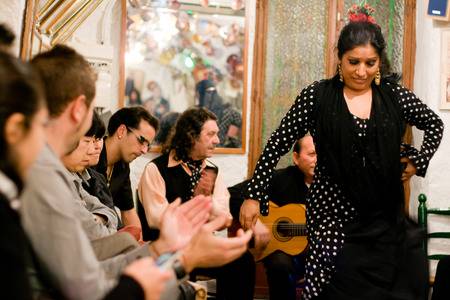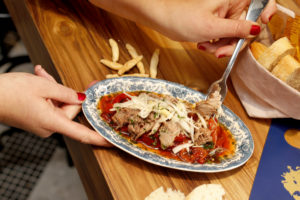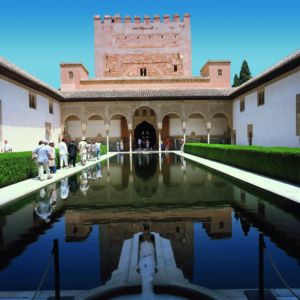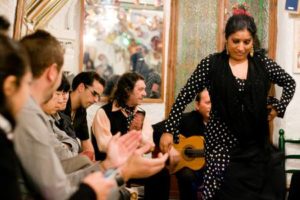
Andalucia is a region of southern Spain rich in culture and traditions. Jews, Muslims and Christians have lived together for centuries, leaving a deep impression on their customs, gastronomy, art and
history. Flamenco was born in these lands as a cry of hope for the most disadvantaged. It is an art that
grows from the people. It is pure passion, suffering, joy and love for life. All this is reflected in the singing but also in the way of dancing. Flamenco reflects the culture of an entire people, their way of being.
This trip brings us closer to the depths of Andalucia, their way of understanding life, singing, dancing, enjoying each day as if it were the last.
Seville, Jerez, Cadiz, Granada. This is the perfect trip for those interested in Flamenco Music and its culture. But also curious about Andalucía’s food and heritage.
We can organize a private tour of Andalucia just for you. Send us an email: info@spainismusic.com
Here is an example:
Day 1, Saturday. Seville
Arrival to Hotel
After an informative session about the trip, your guide will take you to a nice walk around the city
to get to know the culture of Seville for the first time with a delicious gourmet tapas tour.
Day 2, Sunday. Seville
Walking tour and introduction to flamenco Seville is a totally flat city with an exceptional
climate with more than 2,898 hours of sunshine per year. It is the perfect place to walk around. So,
after a good breakfast we will discover places such as the Palacio de San Telmo, the Giralda or the
Torre del Oro. The stop to eat will be in one of the best food markets of the city where we can choose between many options of fresh and local products. Fish, tapas, fruits and vegetables, meats, good wines
and juices to regain strength. Be ready for the truly Mediterranean diet.
The fun continues with an afternoon full of music. We will attend an introductory flamenco class
where a professional guitarist will explain the history and rhythms in a practical and fun way.
Day 3, Monday. Jerez de la Frontera/Cádiz
Few places in Spain enjoy an international recognition like that enjoyed by Jerez. Thanks to
its wine – the “jerez” or “sherry” -, the equestrian and bullfighting tradition, flamenco
and the motor, the name of this Andalusian city has long since crossed borders.
Many say that Jerez is were Flamenco was born.
After a short walk around the city we will visit one of its famous wineries with a delicious wine
tasting and tapas that will accompany a private Flamenco Concert that will find the connections
between the wines and different Flamenco Rhythms (palos).
Afternoon Tour of Cadiz. Later in the afternoon, Cadiz is waiting for us. Known as the city of joy we will wander around its historical quarter while tasting mouth watering local food.
Day 4, Tuesday. Deep Andalucía
Today we enter the deep Andalucía, between mountain ranges, olive groves, rivers and Mediterranean meadow. On our way to Granada we will make a stop in Ronda. Ronda is located in the heart of the Serrania de Ronda, about 100 km from the city of Malaga. Surrounded by lush river valleys and sitting on a deep ravine. It is worth going through the Puente Nuevo with spectacular views, the bullring, one of
the oldest in Spain, and the Arab baths. We follow our way to make a stop at a farm dedicated to fighting bulls. We know that there is a great debate about the world of bulls and for this reason we want to show you how it works. How bulls live in the countryside, the history of bullfighting, what is a bullfighter and how they learn bullfighting, its influence to Flamenco. Our intention is to give you all the information so you can have your own opinion. The farm is located in the middle of an impressive natural landscape. It is part of a nature reserve protected by the state. After such an intense day we will arrive to Granada for a short walk through the old part of the city.
Day 5 Wednesday. Granada. La Alhambra
Nobody forgets the first time they see the Alhambra, the most spectacular and famous Arab construction in the world. From any point of the city, you can see the shape of a ship, dotted with cypresses, a monument that has been the emblem of Granada for twelve centuries.
The Alhambra has been a palatial city, palace of kings and fortress, all in one. The whole is a
surprising construction: it has no main façade, no center, no particular axis. Buildings, towers,
palaces, courtyards and gardens are happening naturally. Free afternoon to relax
Day 6, Thursday. Granada, Sacromonte and Albaicín Tour plus Flamenco Dance Experience
At the foot of the Sierra Nevada, between the Darro and Genil rivers, Granada is one of the most beautiful cities in the world. The fact of being the last city reconquered by the Catholic
Monarchs in 1492 gives Granada an unmistakable Arabic flavor. Its gastronomy, craftsmanship and urbanism are determined by its glorious historical past. Fountains, viewpoints and Cármenes, the houses surrounded by characteristic gardens, contribute to create unforgettable corners. One of its old
neighborhoods, the Albaicín, is a World Heritage Site along with the Alhambra and the Generalife.
Time to visit the most artsy quarters; Albaycin and the Sacromonte caves where Fla menco has
seen many artists grow. In one of the caves we will join a flamenco dance lesson. Be ready to
move your arms and legs to the sound of a guitar.
Free Afternoon. During the evening we will have dinner while enjoying a flamenco show at the oldest Flamenco Association (Peña) in the world. A place full of history.
Day 7, Friday. Cordoba. Visit to the Mosque and Sephardic Experience. Sephardic Tour and Private Concert.
New day, new experiences. We drive to Cordoba. Today we will discover the Sephardic quarter; we
will go back to the Jewish culture that coexisted with Muslims and Christians for centuries.
Listen to their music that was so present in the every day routines. Time for lunch. Traditional kitchen that serves culinary delicacies from Sefarad and Al-Andalus. Cordoba’s Mosque. In the afternoon we will visit one of the most important monuments in the history of humanity; Cordoba’s Mosque. The Mosque-
Cathedral Monumental Site of Cordoba summarises our identity like few other buildings can. The complexity of the history on display here creates one of its most beautiful examples.
It is a living building which visibly integrates the historic layers of different cultures and
civilisations
- Tapas
- La Alhambra
- Flamenco
REQUEST A DETAILED ITINERARY
A brief history of Flamenco
We lack precise references to know at what point in history Flamenco arose. Due to the diverse cultures that passed through our land, flamenco has numerous influences from multiple origins (Greek, Roman, Muslim, gypsy…) The Andalusian music, resulted from the fusion between the one coming
from North Africa, the Christian and the Jewish. There is a time when we can begin to treat flamenco in a professional and documented way. Between 1765 and 1860. It is from this period where three
major outbreaks would begin to emerge, which would be Cádiz, Jerez de la Frontera, and the Triana neighborhood, in Seville. An interesting fact is that flamenco is accompanied only by the touch of the
palms and not with the guitar that characterizes it today. It is from 1860 until around 1910, where flamenco begins to evolve, giving name to this period as the Golden Age of Flamenco. This began
accompanying with instruments, singing and dancing. Opera Flamenca. Between 1910 and 1955, flamenco led to a new stage, whose name was Opera Flamenca. This era is characterized by lighter cantes, known in ourdays as the fandango, and round-the-clock cantes, a musical style brought by
immigrants from Latin America. The next period of flamenco, would be known as the Renaissance of
Flamenco emerged from 1955. Now flamenco begins to develop in flamenco tablaos, theaters and festivals, where they had great dance personalities, who pushed flamenco to what it represents today. Paco de Lucía marks the beginning of a stage full of splendor where the guitar acquires a universal
dimension. From this moment, flamenco continued to evolve, becoming universal. We can notice how new trends with other musical styles are appearing from the hand of some artists. This has led to a controversy between the defenders ofthe conservation of Flamenco Orthodoxy, and others more interested in its evolution and its permeability. The future of flamenco is promising, given its declaration as a World Heritage Site by UNESCO.
REQUEST A DETAILED ITINERARY



